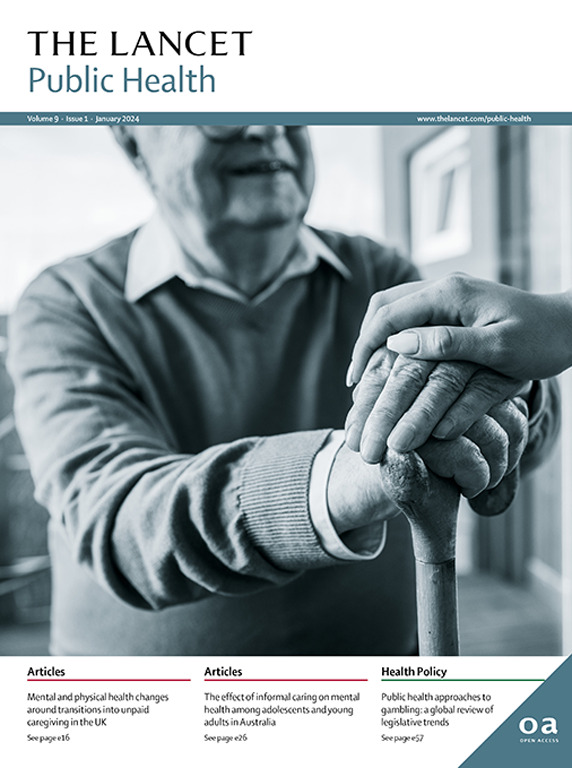烟草税和社会经济不平等对94个低收入和中等收入国家5岁以下儿童死亡率的影响:一项纵向生态学研究
IF 25.4
1区 医学
Q1 PUBLIC, ENVIRONMENTAL & OCCUPATIONAL HEALTH
引用次数: 0
摘要
虽然增加烟草税可以提高儿童存活率,但很少有数据表明它们对儿童死亡率中社会经济不平等的影响。我们调查了在低收入和中等收入国家(LMICs)中,卷烟税与5岁以下儿童(以下简称5岁以下儿童)死亡率的社会经济不平等之间的关系。方法采用纵向生态学研究。我们将世界银行定义的94个中低收入国家的年度国家级数据与联合国机构间儿童死亡率估计小组2008年至2020年按财富五分位数划分的5岁以下儿童死亡率年度数据联系起来。我们使用固定效应面板回归模型来评估烟草税与按财富五分位数划分的5岁以下儿童死亡率的绝对和相对不平等之间的关系。研究发现,将卷烟总税提高10个百分点,与所有财富五分之一人群中5岁以下儿童死亡率的降低有关。将卷烟总税从0 - 24.9%提高到25.0 - 74.9%和75.0%或更高,分别与5岁以下儿童死亡率绝对不平等降低3.8%(95%可信区间为0.2 - 7.3)和7.6%(1.4% - 13.4)相关。这一发现主要归因于特定税收,每增加10个百分点,绝对不平等就会减少1.4%(0.3至2.6)。我们估计,在所有94个中低收入国家将总卷烟税提高到75.0%或更高,可在2021年避免281017例(196916至362301)5岁以下儿童死亡。高卷烟税与中低收入国家儿童死亡率绝对不平等程度的大幅下降有关。这些发现支持将卷烟税提高到世卫组织建议的零售价值的75%或更高,以保护最贫穷的儿童。瑞典健康、工作生活和福利研究委员会;瑞典瑞典银行;欧盟“地平线2020”研究与创新计划;以及英国国家健康与护理研究所。本文章由计算机程序翻译,如有差异,请以英文原文为准。
Cigarette taxation and socioeconomic inequalities in under-5 mortality across 94 low-income and middle-income countries: a longitudinal ecological study
Background
Although increasing cigarette taxes is known to improve child survival, there are few data on their effect on socioeconomic inequalities in child mortality. We investigated the association between cigarette taxation and socioeconomic inequalities in mortality in children younger than 5 years (hereafter referred to as under-5 mortality) in low-income and middle-income countries (LMICs).Methods
This was a longitudinal ecological study. We linked country-level annual data on 94 LMICs, as defined by the World Bank, and annual data on under-5 mortality by wealth quintile from the UN Inter-agency Group for Child Mortality Estimation from 2008 to 2020. We used fixed-effect panel regression models to assess the association of cigarette taxes with absolute and relative inequalities in under-5 mortality by wealth quintile.Findings
Increasing total cigarette tax by 10-percentage-points was associated with reduced under-5 mortality rates in all wealth quintiles. Raising total cigarette tax from 0·0–24·9% to 25·0–74·9% and 75·0% or more of their total retail value was associated with 3·8% (95% CI 0·2 to 7·3) and 7·6% (1·4 to 13·4) decreases in absolute inequality in under-5 mortality, respectively. This finding was mainly attributable to specific tax, which was associated with a 1·4% (0·3 to 2·6) reduction in absolute inequality for each 10-percentage-point increase. We estimated that raising total cigarette taxes to 75·0% or more in all 94 LMICs could have averted 281 017 (196 916 to 362 301) under-5 deaths in 2021.Interpretation
High cigarette taxes are associated with a large decrease in absolute inequality in child mortality in LMICs. These findings support raising cigarette taxes to the WHO-recommended 75% or more of the retail value to protect the poorest children.Funding
Swedish Research Council for Health, Working Life, and Welfare; Stiftelsen Riksbankens Jubileumsfond; European Union's Horizon 2020 Research and Innovation; and UK National Institute for Health and Care Research.求助全文
通过发布文献求助,成功后即可免费获取论文全文。
去求助
来源期刊

Lancet Public Health
Medicine-Public Health, Environmental and Occupational Health
CiteScore
55.60
自引率
0.80%
发文量
305
审稿时长
8 weeks
期刊介绍:
The Lancet Public Health is committed to tackling the most pressing issues across all aspects of public health. We have a strong commitment to using science to improve health equity and social justice. In line with the values and vision of The Lancet, we take a broad and inclusive approach to public health and are interested in interdisciplinary research.
We publish a range of content types that can advance public health policies and outcomes. These include Articles, Review, Comment, and Correspondence. Learn more about the types of papers we publish.
 求助内容:
求助内容: 应助结果提醒方式:
应助结果提醒方式:


